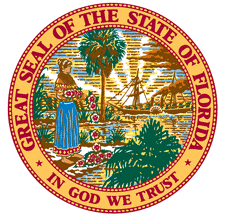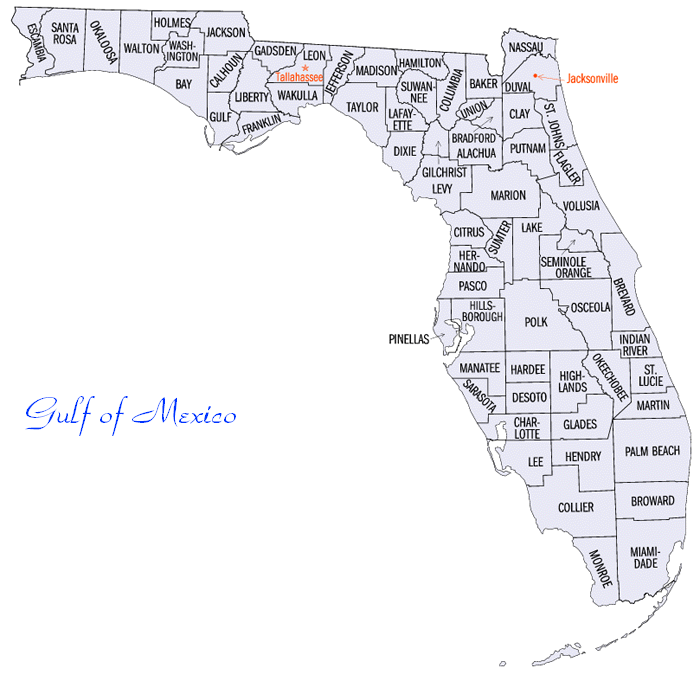Florida
A state of the southeast United States bordering on the Atlantic Ocean and the Gulf of Mexico. It was admitted as the 27th state in 1845. The peninsula was explored by Juan Ponce de León in 1513 and became the center of a Spanish settlement that included the southeast part of the present-day United States. Spain finally ceded the area in 1819. Tallahassee is the capital. Florida is bordered by Georgia and Alabama (N), Atlantic Ocean (E) and the Gulf of Mexico (W). Named on Easter, 1513 by Ponce de Leon for Pascua Florida, meaning “Flowery Easter”

Abbreviation: FL
Capital City: Tallahassee
Date of Statehood: Mar. 3, 1845
State #: 27
Population: 15,982,378
Area: 65758 sq.mi. Land 53997 sq. mi. Water 11761 sq.mi.
Highest Point: Britton Hill; 345 feet (105 m), 50th
State Bird: Mockingbird
State Flower: Orange Blossom (Citrus sinensis)
State Motto: In God We Trust
State Nickname: Sunshine State
State Song: “Old Folks at Home (Suwannee River)” by Stephen C. Foster
State Insect: Zebra Longwing Butterfly [5]
State Tree: Sabal Palm
State Reptile: American Alligator
State Animal: The Florida Panther
State Saltwater Mammal: The Manatee
State Drink: Orange juice
State Fruit: Orange
State Shell: The Horse Conch (The great band shell)
State Saltwater Fish: The Sailfish
State Freshwater Fish: Florida Largemouth Bass

About the Flag
Adopted in 1899, on a white field emblazoned with a red X and the state seal, Florida’s flag represents the land of sunshine, flowers, palm trees, rivers and lakes. The seal features a brilliant sun, a cabbage palmetto tree, a steamboat sailing and a Native American Seminole woman scattering flowers
History
Early Spanish and French Exploration
Although the Florida peninsula was probably sighted by earlier navigators, the Spanish explorer Juan Ponce de León is credited as the first European to visit the area. Seeking the fabled Fountain of Youth, Ponce de León landed near the site of Saint Augustine in 1513. He claimed the area, which he thought was an island, for Spain and named it Florida, probably because it was then the Easter season (Pascua Florida). Other Spanish adventurers, notably Pánfilo de Narváez and Hernando De Soto, later explored the region and established the fact that Florida was not an island. The vast region that comprises most of the SE United States was claimed for Spain, the whole being known as Florida.
It was the activity of the French in the area, however, that led to actual Spanish settlement of the Florida peninsula. In May, 1562, Jean Ribaut had discovered the St. Johns River, and two years later René de Laudonnière built Fort Caroline at its mouth. Alarmed at this encroachment by the French, Philip II of Spain commissioned Pedro Menéndez de Aviles to drive the French out of the area; this he did ruthlessly. Spanish colonization began when Menéndez founded St. Augustine in 1565. Florida had no precious metals to spur conquest (as in Mexico and Peru), its soil seemed infertile (Spanish Florida was never self-sufficient agriculturally), and the Native Americans resented their encroachment. However, the Spanish were compelled to hold Florida because of its strategic location along the Straits of Florida, through which rich treasure ships from the south sailed for Spain.
English Colonization
In the 1600s the English, who were trying to expand their American colonial holdings after 1607, began to threaten Florida. St. Augustine was attacked several times by English corsairs and in 1702–3 was besieged by a force from the English colony in South Carolina. In 1742, English colonists from Georgia under James E. Oglethorpe, Georgia’s founder, defeated the Spanish in the battle of Bloody Marsh on St. Simons Island, making Florida’s northern boundary the St. Marys River. Spain’s last-minute entry (1762) into the Seven Years War cost her Florida, which the British acquired through the Treaty of Paris (1763).
Under the British (1763–83), Florida was divided into two provinces, and St. Augustine and Pensacola were respectively made the capitals of East Florida and West Florida. Under the Treaty of Paris (1783), Florida was returned to Spain. Many colonists in Florida abandoned the region and moved to British possessions in the West Indies. Spain’s hold over Florida, however, was extremely tenuous. Boundary disputes developed with the United States (see West Florida Controversy). In the War of 1812, Pensacola served as a British base until captured (1814) by U.S. General Andrew Jackson.
U.S. Occupation
In 1819, after years of diplomatic wrangling, Spain reluctantly signed the Adams-Onis treaty ceding Florida to the United States in return for U.S. assumption of $5 million in damages claimed by U.S. citizens against Spain. Official U.S. occupation took place in 1821, and Andrew Jackson was appointed military governor. Florida, with its present boundaries, was organized as a territory in 1822, and William P. Duval became its first territorial governor.
Settlers poured in from neighboring states, settling especially in the area around the newly founded capital of Tallahassee. A plantation economy flourished there, with cotton and tobacco the chief crops. Settlement expanded southward and displaced the Seminoles, and wars with them seriously impeded Florida’s development. A group of Seminole, under Osceola, resisted attempts to move them to the West, but eventually most of them were transported out of the region at the end of the Second Seminole War (1835–42). However, a small band fled to the wilderness of the Everglades and their descendants live on reservations in the Lake Okeechobee area.
Statehood, Civil War, and Reconstruction
Florida was admitted to the Union in 1845 as a slaveholding state. After Abraham Lincoln was elected President in 1860 proslavery sentiment in Florida led the state to secede from the Union in 1861 and join the Confederacy. Florida furnished vital supplies (particularly salt and cattle) to the Confederacy. The most important Civil War engagement fought in Florida was the battle of Olustee (Feb. 20, 1864), a Confederate victory.
After the war Florida was placed under military rule by Congress. A constitution was drafted providing for black suffrage, and the state was readmitted to the Union in 1868. The constitution had been drafted by moderate Republicans, some of whom were from the North, and these same Republicans held most political offices until 1876, when the Democrats were returned to power and African Americans were once again relegated to an inferior position. In 1885 a new constitution replaced the Reconstruction charter of 1868.
Land Booms
In 1881 Florida sold 4,000,000 acres (1,618,800 hectares) of land to real-estate promoters. Northern capitalists such as Henry M. Flagler built railroads and hotels, and Florida began to develop. The drainage of the Everglades, begun in 1906, precipitated one of the state’s periodic land booms. Because of environmental degradation due to farming these drained lands, areas are now being restored to their natural state through reflooding. The most famous of Florida’s land booms started after World War I and reached its peak in 1925 when land values achieved fantastic heights, only to collapse completely the following year.

|
||||||||||||||||||||||||||||||||||||||||||||||||||||||||||||||||||||||||||||||||||||||||||||||||||||||||||||||||||||||||
|
